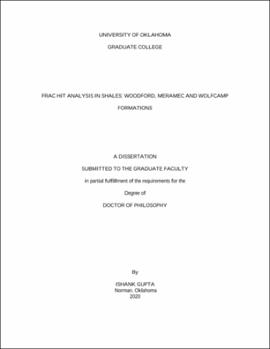| dc.description.abstract | Frac hit was initially coined to refer to the phenomenon when an infill well fracture interacts with the adjacent well during the hydraulic fracturing process. But, over the years, its use has been extended to any type of well-interference or interaction in unconventional reservoirs. Frac hit impact is dictated by a complex interplay of petrophysical properties (high-perm streaks, mineralogy, matrix permeability and natural fractures), geomechanical properties (near-field and far-field stresses, tensile strength, Young’s modulus and Poisson’s ratio), completion parameters (stage length, cluster spacing, pumping rate, fluid and proppant amount) and development decisions (well spacing, completion design and well scheduling).
It is difficult to predict the impact of frac hits because they impact both parent and child wells. The impact on the child wells is predominantly negative but the impact on parent wells can be either positive or negative. Overall, frac hits tend to negatively impact the production. The different strategies proposed to minimize negative impact of frac hits are codevelopment thus avoiding parent-child wells (Tank, Cube development methods), repressuring or refracturing parent wells, using far-field diverters and high permeability plugging agents in child wells frac fluid, optimizing stage and cluster spacing through modeling studies and field tests to reduce stress shadow effects and promote uniform fracture growth.
First, to understand the impact of frac hits and maximize utilization of public databases, an automated machine-learning workflow was developed. The workflow helped analyze over 6000 wells from Meramec, Woodford and Wolfcamp. We systematically evaluated field production and completions data to understand the impact of frac hits on the parent and the child wells production. The parent wells in all three formations had both positive and negative impact of the frac hits. Around 60-67 % wells were negatively impacted while 33-40 % wells were positively impacted. For the child wells, 71-85 % wells were negatively impacted and 15-29 % of the wells were positively impacted. Overall, i.e., combining the impact on parent and child wells, the impact is dominated by the child wells as 69 to 82% of the parent-child pairs were negatively impacted and only 18-31 % of the pairs were positively impacted. Considering percent loss in the cumulative oil volumes in the next 5-years, in the Meramec, parent wells on average show a 16% reduction while child wells show a 39% reduction due to frac hits. The corresponding numbers for the Woodford formation are 19% and 37% and for the Wolfcamp formation are 20% and 22%, respectively. This translates to a parent well losing on average 40-50 kbbls over the next five years and a child well losing on average 80-150 kbbls over the same period. Together a parent-child pair can lose on average between 125 to 225 kbbls in the 5-year period. The results show that the key factors governing the extent of the impact are the extent of depletion and producing oil rates of the parent well before frac hit, completion design parameters (fluid and proppant amount) and well spacing. Machine learning based regression models were also developed to predict the impact of frac hits. These regression models were then coupled with economic analysis to determine optimum spacing for any given completion design or optimum completion design for any given spacing.
Next, an independent analysis was done in small regions (< 10 wells) where extensive data like core, logs, microseismic and fiber optics were available to tie the impact of frac hits to the petrophysical and geomechanical properties of the rocks. One such study was done in Meramec formation. The logs were used to calculate pore pressure and closure stress profiles, mechanical properties such as Young’s modulus and Poisson’s ratio. Fracture modeling and microseismic data helped to understand fracture growth, i.e. fracture dimensions, complex versus planar fracture networks, inter-stage interactions and stress shadow effect. This additional information provided critical insights into frac hits and how they can be managed. The field data was complemented by extensive numerical modeling in GOPHER which was used to carry out sensitivity studies with different completion design parameters. The key findings were while fracture fluid is likely the most important factor governing fracture geometry, amount of proppant directly correlates to fracture width and fracture conductivity. Additionally, large number of clusters per stage can cause disproportionate fracture growth and increase the risk of frac hits. Latin hypercube sampling was used to optimize number of simulations required to generate response surfaces for fracture height and length that can be used to select the best design to maximize production and minimize frac hits.
Another study was done in Marcellus where the analysis shows that the pre-existing natural fracture network controls both the hydraulic fracture geometry as wells as the production from the reservoir. Natural fractures promote complex fracture networks with shorter half-lengths which increase production from the reservoir while minimizing frac hits and neighboring well interactions. The natural fracture network is itself controlled by the geomechanical properties of the rock. A machine-learning workflow was developed to predict the geomechanical facies along the horizontal laterals using the surface drilling data. The facies originally derived using the core- and well-log data can be reliably predicted using drilling data and supervised classification techniques. This machine learning workflow provides a powerful tool for real-time optimization of the wellbore trajectory and completions and minimize frac hits.
Finally, the dissertation concludes with a recommended approach to manage frac hits. There is no silver bullet and problem of frac hits in each shale play is as unique as the shale play itself. But, using all the data available and harnessing the published knowledge, to understand how the fractures propagate downhole, measures can be taken to minimize or even completely avoid frac hits. | en_US |

